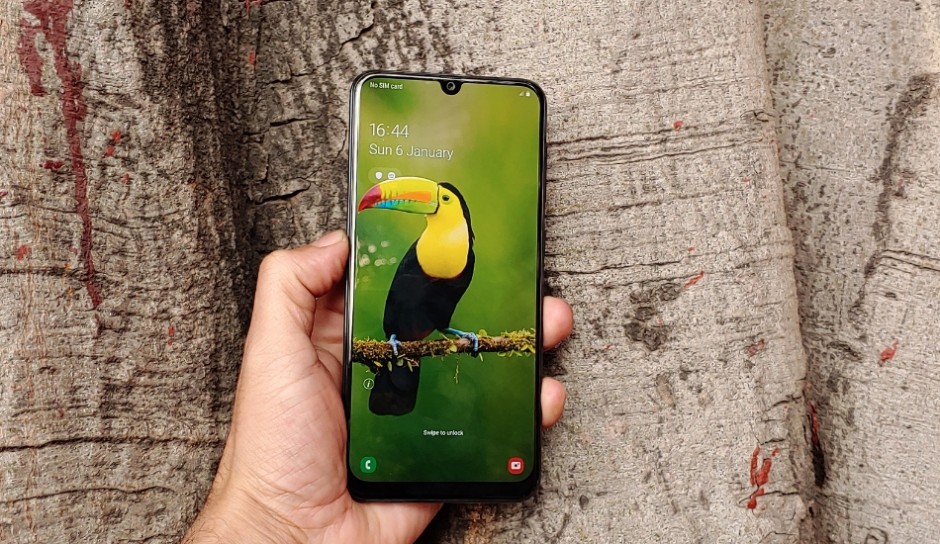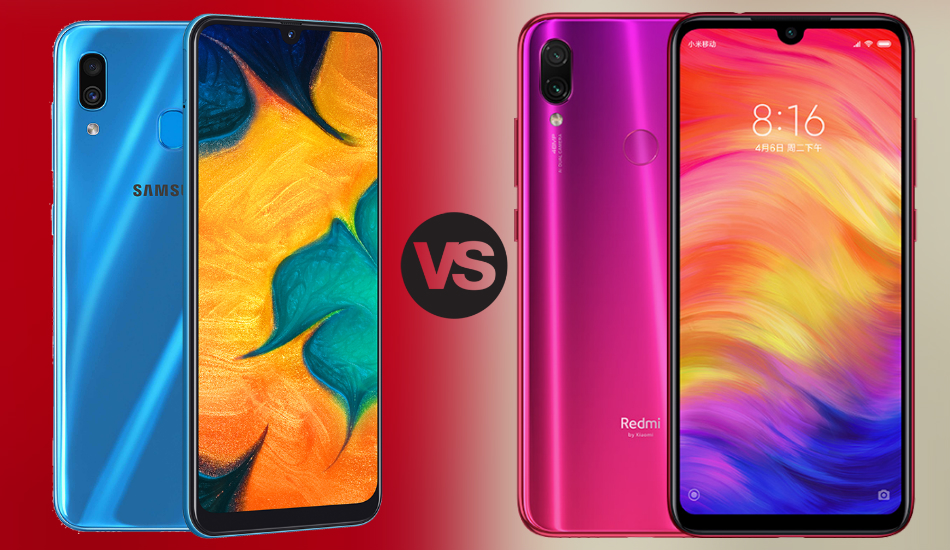Samsung today announced the company’s latest A-series smartphones in India – the Galaxy A50, Galaxy A30 and Galaxy A10. The most attractive of the three for most of us in India is probably the one in the middle and why? Because the Galaxy A30 is carefully priced at Rs Rs 16,990 for its single 4GB RAM with 64GB storage variant.
Does that price remind you of something or perhaps something that’s not even hours old in India? Chances are you’re probably thinking about the Xiaomi Redmi Note 7 Pro (Aaargh, such a mouthful!) which was also unveiled today and yes, for a similar price of Rs 16,999. For almost the same amount of money, which one of these two would you want to buy? If you’re not sure about it, let us help you decide what you get from both these devices and see which one of them suits your needs more than the other.
Design and build:
On first glance, the Galaxy A30 shimmers under any amount of light that’s put on it. It looks like any 2018 mid-range smartphone from the back and it might fool you for a premium smartphone until you get to hold it. We said that because the Galaxy A30 like its elder sibling Galaxy A50 is made of polycarbonate material for its rear side. Apart from that, Samsung has redefined its take on the budget portfolio as it looks to add design as one of its selling points in the future as well.

In contrast to Samsung’s device, the Redmi Note 7 Pro has taken inspiration from the Xiaomi’s other top-end smartphones with a flat glass body that transitions up to the frame. Its back panel is also yet another glossy affair but instead of standard colours, the Redmi Note 7 Pro arrives in Nebula Red and Nebula Blue colours. Not to forget, these glossy colours are protected on the outside by Corning’s Gorilla Glass 5 and not a plastic body like on the Galaxy A30.

Winner: Xiaomi Redmi Note 7 Pro
Display:

The Redmi Note 7 Pro features a 6.3-inch full HD+ display with a 2340 x 1080 pixel resolution and a small waterdrop style notch housing the front camera. Meanwhile, the Galaxy A30 utilises a 6.4-inch Full HD+ sAMOLED display with a screen resolution of 2340 x 1080 pixels. On any given day, an AMOLED screen offers a much pleasant viewing experience over an LCD screen and the Galaxy A30 as an added bonus also offers a larger 85.1 percent screen-to-body ratio over the Redmi Note 7 Pro’s 81.4 percent.
Winner: Samsung Galaxy A30
Hardware:
The Galaxy A30 is powered by an octa-core Exynos 7884 chipset, which is clocked at 1.8GHz. The phone is backed by a 4GB of RAM and 64GB of internal storage. The Exynos 7884 is a variant of the Exynos 7885, which was introduced in 2018. Although the performance of the device is yet to be tested out in different scenarios, we can expect the performance of the phone to come close to the Mi A2 which runs on a Snapdragon 660 processor.
The Redmi Note 7 Pro, on the other hand, comes fuelled by the Qualcomm Snapdragon 675 octa-core Processor with Adreno 612 GPU. The phone has 6GB of LPDDR4x RAM with 128GB storage and expandable storage of up to 256GB through a microSD card.
Performance-wise, the Snapdragon 675 is more efficient than its predecessor – the Snapdragon 660. The Galaxy A30 thus won’t be able to match the Redmi Note 7 Pro’s hardware value and as the latter offers more storage and RAM capacities than its Samsung counterpart.
Winner: Xiaomi Redmi Note 7 Pro
Software:
The Galaxy A30 runs on Android 9.0 Pie with company’s OneUI running on top of it. In our initial review, the interface was smooth since this is the first time Samsung added their One UI to a lower-priced smartphone. It offers a different layout compared to Samsung’s older phones with clever utilisation of screen space. Samsung’s latest UI is also the only custom Android skin to offer an in-built dark mode which triggers a black theme across the phone’s UI to better usability during the night.

The Redmi Note 7 Pro runs on Android 9 Pie with MIUI 10 on top with a slew of customisations and features. While there’s no App drawer, stuff like quick toggles is similar to what we’ll see on a Stock Android Pie running phone. The single swipe brightness slider is the more convenient feature yet and so are the inbuilt gestures which allow one hand usage. While MIUI is more usable on a daily basis than One UI, the latter is more polished and has a lesser learning curve to the Xiaomi phone.
Winner: Samsung Galaxy A30
Camera:
For the camera department, the Redmi Note 7 Pro equips a dual rear camera setup with a 48-megapixel primary sensor with f/1.8, 1/2″, 0.8µm, PDAF and a 5-megapixel f/2.4, depth sensor working in unison. the main sensor uses a Quad Bayer arrangement with that can generate 12 million big 1.6µm pixels each. The benefit of this is to get sharper 12MP pictures with less noise and more details. The front camera comes with a 13-megapixel AI sensor for selfies.

The Galaxy A30 is equipped with a dual-camera setup with a combination of 16-megapixel primary lens and a 5-megapixel ultra-wide angle sensor. For the front, there is a 16-megapixel shooter for selfies and video calling. Initial performance of the Galaxy A30 looks decent as it was able to click some well-detailed photos with sharp focus. But that can’t be compared to a photo clicked from a 48MP sensor and so it’s Xiaomi which steals this round by a big margin.
Winner: Xiaomi Redmi Note 7 Pro
Battery:
Both the Galaxy A30 and Redmi Note 7 Pro offer their users a massive battery that amounts to 4000mAh and we can expect either of them to power its owner through an entire day even with some moderate-to-high usage. However, the A30 gets a slight setback from its Xiaomi counterpart as the Redmi Note 7 Pro comes with Quick Charge 4 support that lets the device charge with an 18-watt power brick. The Galaxy A30 is only bundled with a 15-watt fast charger.
Winner: Xiaomi Redmi Note 7 Pro for added Quick Charge 4 support.
Verdict:
| Samsung Galaxy A30 | Xiaomi Redmi Note 7 Pro | |
| Processor | Exynos 7884 | Snapdragon 675 |
| Display | 6.4-inch FHD+ AMOLED, 2340 x 1080 pixels | 6.3-inch FHD+ LCD, 2340 x 1080 pixels |
| Memory | 4GB RAM, 64GB storage | 6GB RAM, 128GB storage |
| Camera | Rear: 16MP + 5MP; Front: 16MP | Rear: 48MP + 5MP; Front: 13MP |
| Battery | 4,000mAh | 4,000mAh |
| OS | Android 9 Pie, Samsung One UI | Android 9 Pie, MIUI 10 |
| Price | Rs 16,990 | Rs 16,999 |
The Galaxy A30 and Redmi Note 7 Pro both have different USPs and with that comes different use cases. The A30 is a proper all-rounder as it offers a welcome change in design from Samsung’s side, AMOLED Display on a budget, mid-range internals, a polished software, dual cameras and a large 4,000 battery to get you through the day. For almost the same price, users can also look at the Redmi Note 7 Pro as it offers a sturdier build through a Gorilla Glass 5 protection, a new and improved processor, the same large battery and a major camera overhaul that makes sharper pictures with a 48MP sensor. So if the display and camera isn’t something you’re concerned about, you can opt for the Note 7 Pro. If not, the Samsung Galaxy A30 is pretty much convincing on all fronts.


